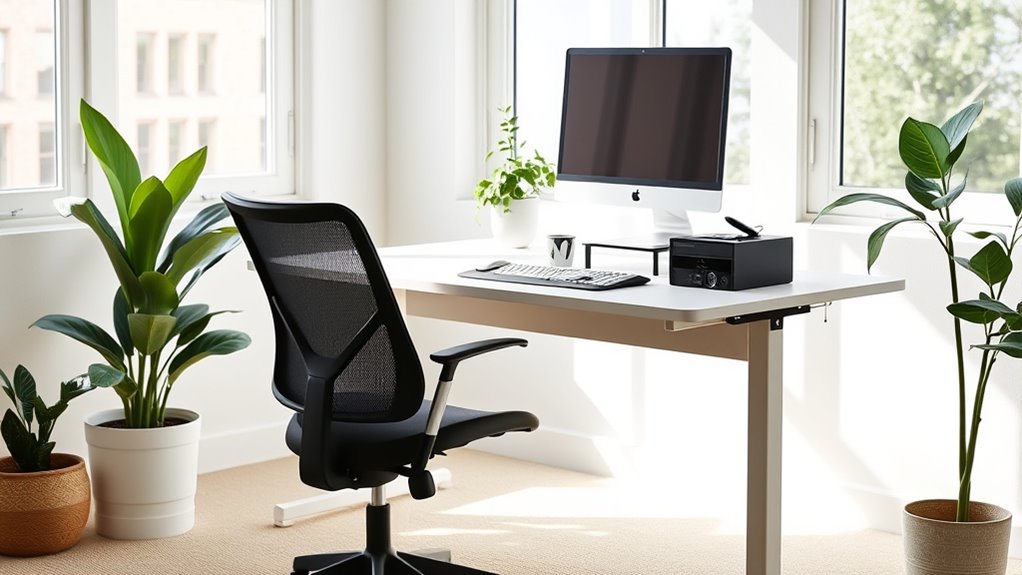To establish a pain-free home office, focus on proper lighting and ergonomic accessories. Position your desk near a window for natural light and use adjustable LED lamps to prevent eye strain. guarantee your monitor is at eye level, and sit in an ergonomic chair with lumbar support, feet flat on the ground, and proper posture. Small adjustments like footrests or monitor stands make a big difference—continue exploring to learn more tips for a comfortable workspace.
Key Takeaways
- Maximize natural light exposure by positioning your desk near windows to reduce eye strain and improve focus.
- Use adjustable LED desk lamps to ensure bright, even lighting and minimize glare on screens.
- Set your monitor at eye level with ergonomic stands and support proper posture with lumbar cushions and footrests.
- Avoid placing monitors directly in front of or behind light sources to prevent reflections and visual discomfort.
- Invest in ergonomic accessories that promote correct posture, reducing fatigue and preventing musculoskeletal pain during remote work.

With more people working from home than ever before, prioritizing good ergonomics is vital to stay comfortable and avoid injury. One of the first things to consider is your office lighting. Proper lighting reduces eye strain and fatigue, helping you stay focused throughout the day. Natural light is ideal, so position your desk near a window if possible. If natural light isn’t enough, supplement with adjustable LED desk lamps that provide bright, even illumination without harsh glare. Avoid placing your monitor directly in front of or behind a light source to prevent reflections and eye discomfort. Consistent, well-placed lighting keeps your workspace bright and minimizes the need to squint or strain your eyes, making long work sessions more comfortable.
Next, pay attention to ergonomic accessories that make your home office more supportive. Investing in a good ergonomic chair is vital, but you can also enhance comfort with accessories like lumbar supports, footrests, and adjustable monitor stands. Lumbar cushions help maintain the natural curve of your lower back, preventing soreness after hours of sitting. A footrest ensures your feet are flat on the ground, promoting better circulation and reducing pressure on your legs. An adjustable monitor stand helps position your screen at eye level, preventing neck strain and encouraging proper posture. These accessories are small but impactful, making it easier to sit correctly and work efficiently. Additionally, understanding the role of contrast ratio in projectors can help you optimize your home theater setup for better visual comfort during movie nights.
Frequently Asked Questions
How Do I Prevent Eye Strain During Long Screen Hours?
To prevent eye strain during long screen hours, you should adjust your screen positioning so it’s about arm’s length away and slightly below eye level. Use blue light filters to reduce eye fatigue and blue light exposure. Remember to follow the 20-20-20 rule: every 20 minutes, look at something 20 feet away for at least 20 seconds. These steps help protect your eyes and keep you comfortable.
What Are the Best Ways to Reduce Wrist Pain at Home?
Did you know that wrist pain affects up to 20% of office workers? To reduce it at home, prioritize wrist stretches regularly to loosen tight muscles. Use ergonomic keyboards and adjustable mouse pads to maintain neutral wrist positions. Take frequent breaks to avoid prolonged strain, and keep your wrists aligned with your forearms. These habits help prevent discomfort and keep your wrists healthy during long work sessions.
How Can I Improve Posture Without Specialized Equipment?
To improve your posture without specialized equipment, focus on core muscle engagement—sit upright, tighten your abdominal muscles, and avoid slouching. Adjust your desk height so your elbows are at a 90-degree angle, keeping your wrists straight. Regularly take breaks, stretch, and move around to reduce strain. These simple steps help maintain proper alignment, reduce discomfort, and promote better posture during your workday.
Are There Ergonomic Tips for Small or Shared Home Offices?
Imagine fitting a spaceship into a bottle—that’s what designing a small or shared home office feels like. Use compact furniture to maximize space and keep essentials within reach. Privacy solutions, like room dividers or noise-canceling headphones, help create boundaries. Adjust your setup so your screen is at eye level and your chair supports your back. These tips help you stay comfortable and focused, even in tight spaces.
How Often Should I Take Breaks to Stay Comfortable?
You should take breaks every 30 to 60 minutes to stay comfortable. During these breaks, incorporate quick stretching routines to relieve tension and boost circulation. Regular breaks not only help prevent physical discomfort but also support your mental health by reducing stress and improving focus. Keep moving, stretch, and reset your mind—these simple habits make a big difference in maintaining comfort and productivity throughout your workday.
Conclusion
By applying these ergonomic tips, you’re building a sturdy foundation for your home office, turning it into a pain-free sanctuary. Think of your workspace as a well-tuned instrument—when everything’s in harmony, your productivity and comfort hit high notes. Remember, small adjustments now can prevent big discomfort later. So, take charge of your setup, and watch how effortlessly your workday flows, transforming your home office into a haven of health and efficiency.









